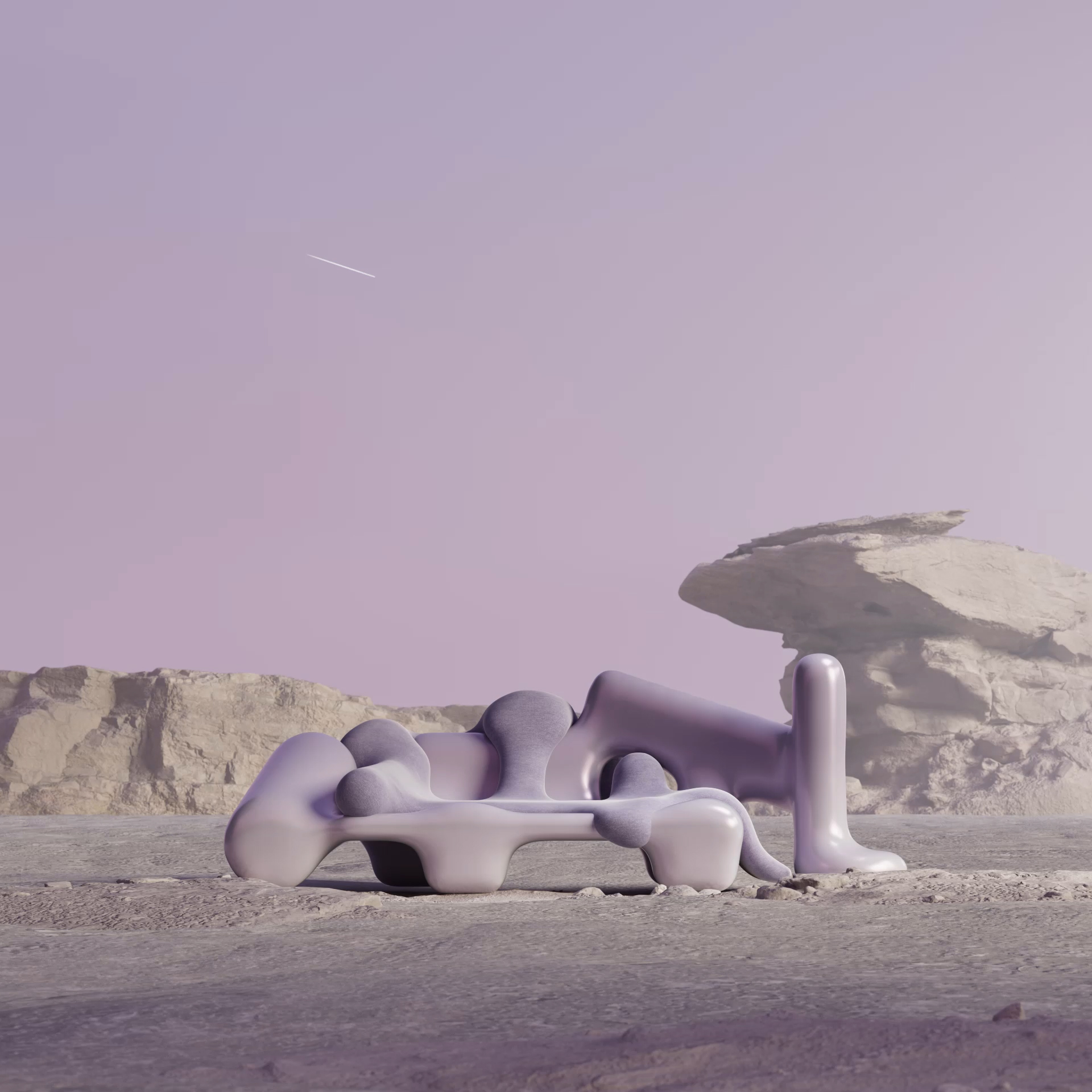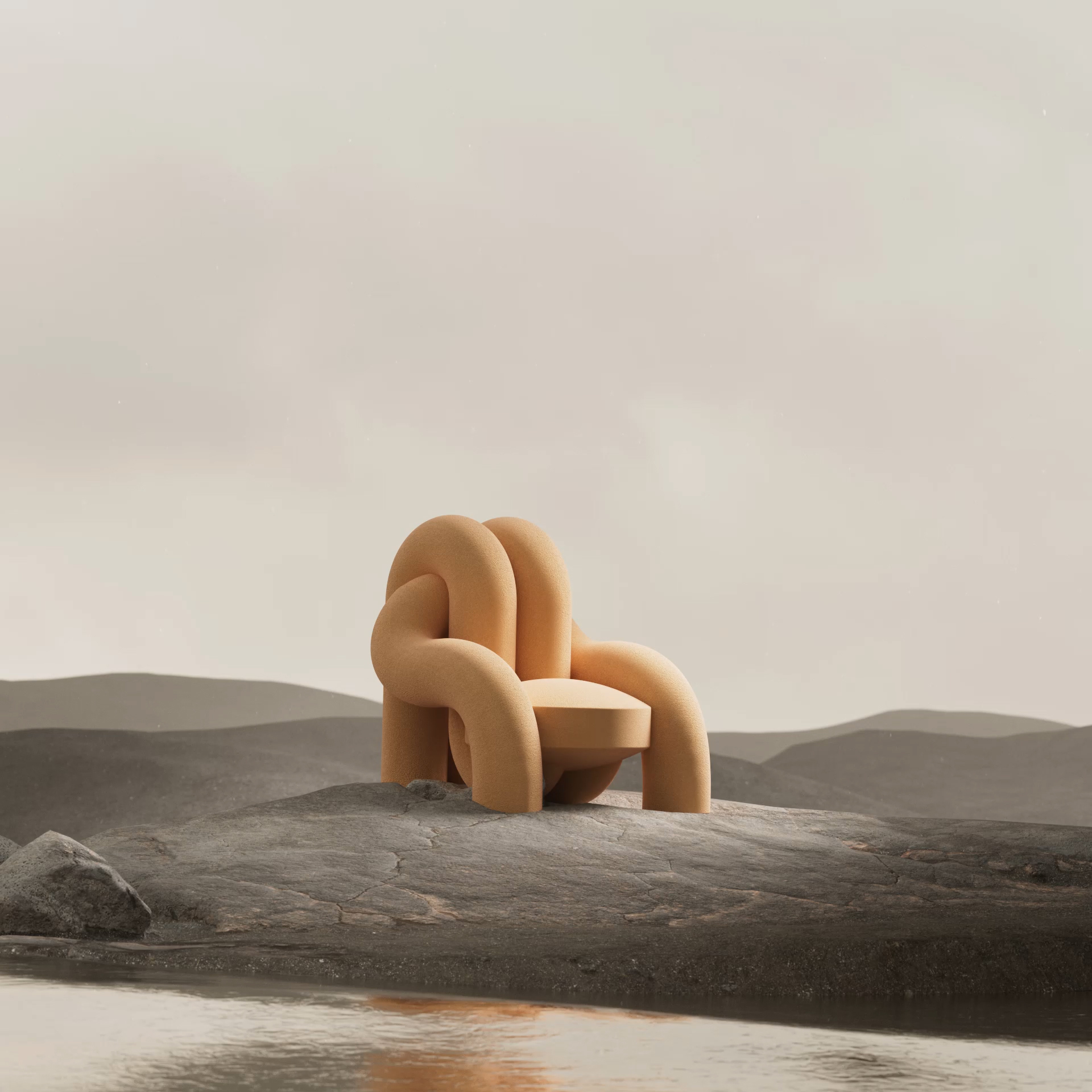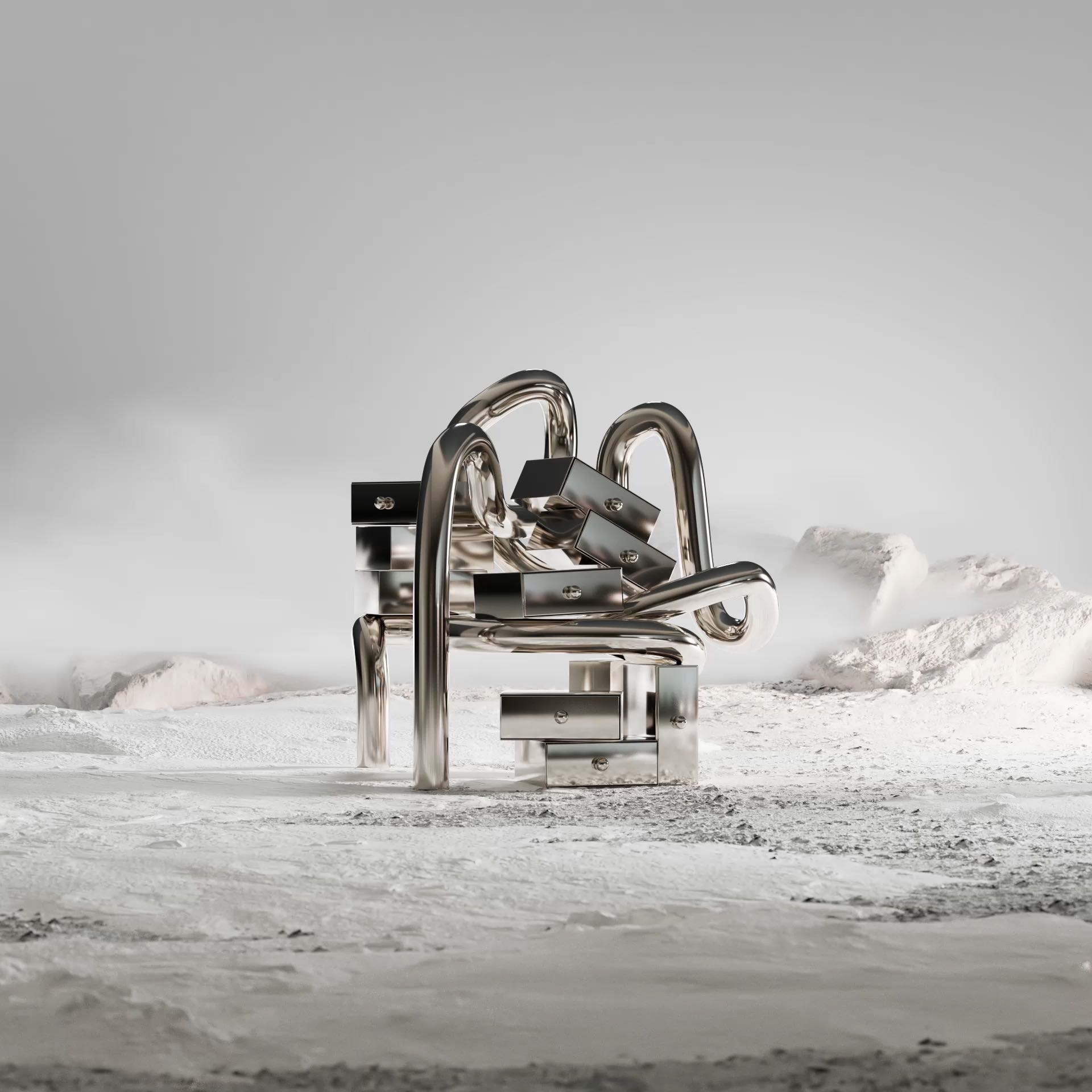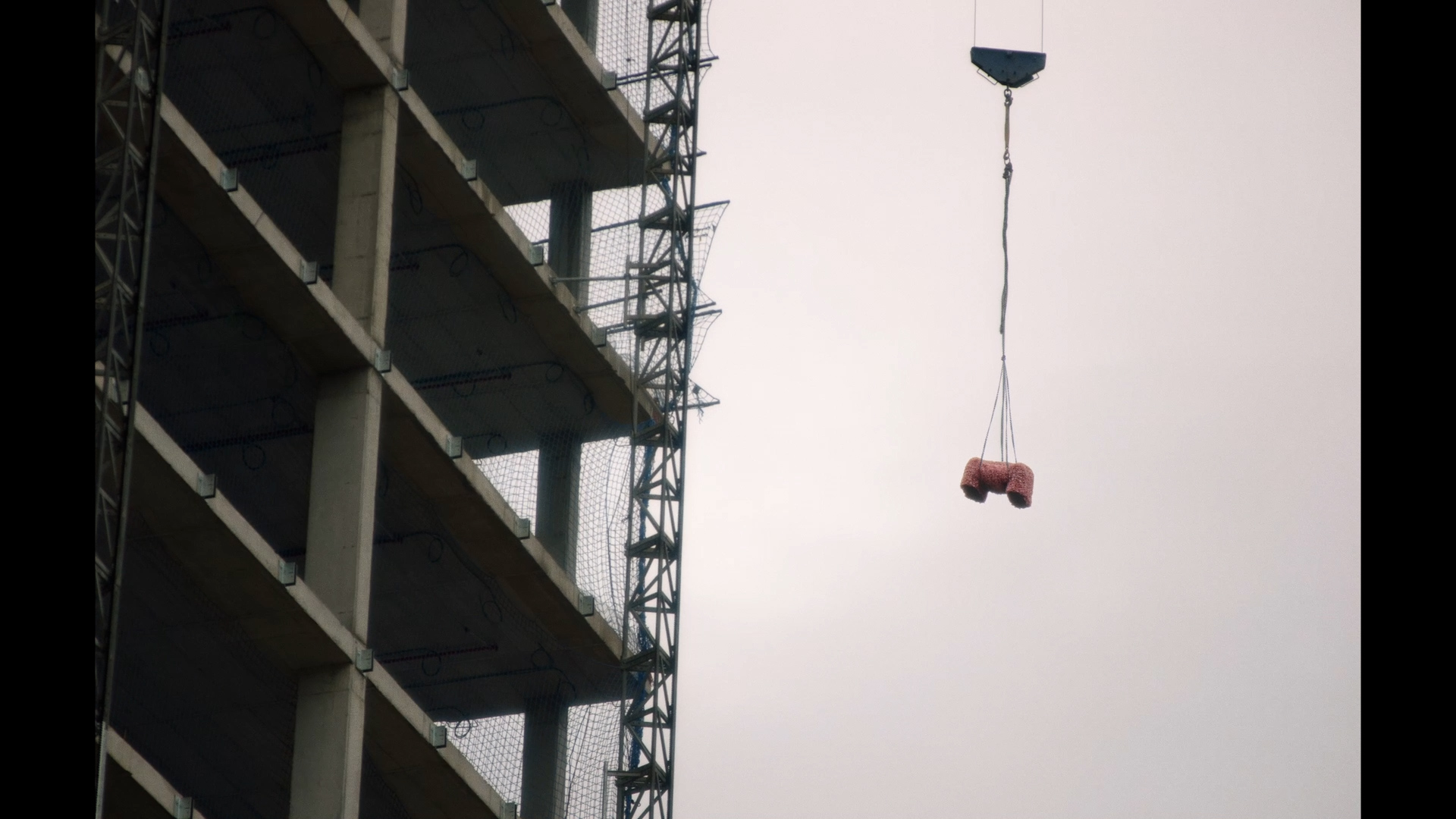Andrés Reisinger of the eponymous Reisinger Studio refers to his practice as “unclassifiable”. Based in Barcelona, the Argentinian artist has become something of a pioneer when it comes to digital art in recent years. For one, Reisinger Studio’s designs are visually arresting – perfectly abstract furniture set within dream-like environments. Reisinger Studio has also been at the forefront of pushing the limits of the digital medium. Take, for example, The Shipping, an NFT collection of ten pieces of ‘digitally-born furniture’ that sold collectively within ten minutes for $450,000 at auction in 2021. Each of the ten pieces of furniture are digitally compatible with virtual open worlds, like Minecraft, whilst five of the NFTs also come with a real-life counterpart. Perhaps, then, it’s possible to ascertain what Reisinger means when he calls his work unclassifiable – certainly, the artist is part of the vanguard of a rapidly emerging scene.
What makes the work of Reisinger Studio so intriguing is that Reisinger is not simply a digital designer – that’s only part of the process. Take, for instance, 2018’s Hortensia Chair, which was also auctioned as an NFT as part of The Shipping. A digitally rendered armchair, Hortensia appears to be covered in hydrangea petals and is imagined in Reisinger Studio’s signature palette of bubblegum pink. It’s characteristic of much of the artist and studio’s work in which the boundaries of reality are not entirely clear. To be certain, speculation over whether or not his work is real is not a concern for Reisinger. As he tells Present Space via email, “the word ‘real’ has no meaning to me; everything that is experienced in our daily life is real to me.” What sets Hortensia apart is not Reisinger’s technical, artistic ability to create something that seems lifelike, but the fact that the opportunity arose to then make it in real life. As the artist explains, “Hortensia started as a 3D digital work that received an incredible amount of interest when posted on social media, to the point where I started receiving requests for it as a physical piece”.



And so, in 2019, Reisinger worked with product and textile designer, Júlia Esqué, to bring Hortensia to life. Following a year of research and development, in which Reisinger and Júlia figured out how to recreate the petal-like texture of Hortensia, the chair was made in a limited batch. But in 2021, the pair collaborated with the Dutch company Moooi to put the chair into wider production – bringing Hortensia to life for a much larger audience. In doing so, Reisinger has been to transcend the boundaries of 3D design. Through this collaboration with Júlia and Moooi, the artist has been able to approach digital design as a medium limitless possibility. A short documentary released in 2022 to chart the development of Hortensia sets out how the collaboration was made possible. Narrated by the chair, it asks “What does it take to be mortal? 200 square metres of pink polyester surface laser cut into long strips of fabric with scalloped edges, ruched together into 500 clusters of 50 distinct petals each”.
But innovation to Reisinger doesn’t just have to manifest itself through re-creating something digital in a physical form. In May 2022, Reisinger Studio unveiled Pollen, a rare NFT series which evolves into a new artwork four times a year, replicating the four seasons in nature. The project takes its name from the process of pollination, and the ways in which nature transforms at various intervals in the year. If nature seems far removed from the unfamiliar realm of NFTs to some, there’s a logical connection for Reisinger. “Nature is the driving force behind the world,” he explains, “[it’s] the most incredible and bewildering machine. I keep discovering many unpredictable parallels that can be traced between digital and nature; I am fascinated by this and interested in finding more.”


Over the course of a year, each collector is given the opportunity to “pollinate” their NFT as the artwork changes with the seasons. In doing so, the collector receives a final version of their NFT, unique to the season in which pollination takes place. Through Pollen, Reisinger Studio once again pushes the limits of digital design, requiring the active participation of each collector. How did the designer come up with this concept? “My work constantly strives to find new and undiscovered potentials and expressions of art,” he says. “With digital technologies, artists can get closer to the public, to collectors, to people and in turn, each other. A collaborative artwork is one of the reflections of this power, and I am particularly interested in artworks that are perpetually changing and developing. It’s a dialogue. I also wanted to thank my collectors with something that could go beyond being another artwork, but rather an experience where they too are functioning participants.”
Hortensia and Pollen are just two examples of the ways in which Reisinger Studio navigates what Reisinger calls “the potential of the digital, and mostly importantly the hybrid realms of virtual and physical.” But there’s something much bigger at play in his vision for what this melding of making and thinking can do. “I believe that the digital realm can teach us how to create outputs that are produced in their ideal technical form as well as being true reflections of the public’s desires.” This can have real-world implications for how we conceive of the physical environment around us. “Instead of producing large quantities of products in the hope of receiving a positive response from the public, we could (truly) reach the point where we only physically produce objects that we are almost certain will be wanted.” That much seems true for Hortensia – in which, by measuring the “digital demand before physical supply,” the designer can avoid waste – material waste, artistic waste, and so on.


Reisinger’s thinking is not just limited to reimagining digital design into physical objects such as furniture. The same approach he has taken through projects such as Hortensia can, he notes, “be applied to the organisation of cities: defining the ideal buildings, settings, placements in the metaverse and then applying them to the physical world. It is much easier, as well as saving plenty of resources, to test and trial in the digital realm.” By Reisinger’s logic, then, the metaverse is not so much an alternative to the physical world around us – a dystopian distraction from the problems that the planet faces, in terms of the climate crisis and unliveable cities – but part of the solution. For Reisinger, we can leverage the potentials of digital design to our benefit, “instead of building unsustainable cities that don’t function and where no one wants to, or can, live. In general, by migrating a large portion of our daily culture to the digital realm we could greatly minimise the impact of physical production, and save so much of the litter that we continuously create.”
